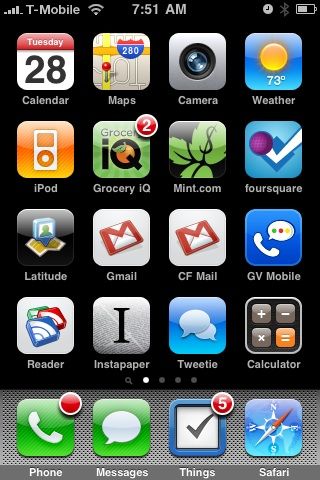I love the iPhone (on T-Mobile). It’s been an awesome phone slash iPod slash internet device for me for almost two years now. As I check out some of the other mobile phones out there I realize I may never leave the iPhone because of its applications.
It’s always fascinating to me to see what other people’s home screen looks like (what applications do you use the most? why is that one up there? why do you have two red icons next to each other? etc.) and I’ve found some of my favorite applications just by seeing what other people use.
In fact, word of mouth, like many other products, is the best way to find the best applications. Talking to a trusted source with similar interests and behaviors is a great way to find applications that match your lifestyle. Matt Galligan introduced me to Grocery IQ and it’s served as my grocery list ever since.
So, with that said, here are my favorite underrated apps for the iPhone:
Instapaper is one of the greatest free services on the web. Marco has spent a lot of time building a site where you can flag web pages you want to read later (built in to Tweetie, bookmarklet available, etc.). Instapaper takes the page, saves it, and adds it to your very simple list of unread articles.
The iPhone application is perfect because it syncs with your Instapaper account, downloads the text-only (optional) version of the page, and allows you to read it on your phone. The fonts are customizable, the orientation can be swapped (portrait/landscape) and it even uses the accelerometer for tilt scrolling (look ma, no finger swiping). Even though I don’t need all of the ‘Pro’ functionality, I bought this app just to support an excellent product. Instapaper Pro (download) has changed the way I poop.
If you use the web-based money management service Mint, then the iPhone app is the natural compliment to the site. The application shows your account balances, recent transactions, and budgets. Everything you need in your pocket to decide “should I really buy a burrito for lunch?” or “should I really be buying a round of shots tonight?”
You may not focus on finances that often but by having the application, you can check your money’s pulse in a few taps and start to understand important things like: where is my money going? Am I on track this month? Mint (download) has helped me cut costs and optimize my spending.
Hands down, foursquare is one of the best location based applications available. You simply ‘check-in’ to the various places you visit (socially) and start to gain points and badges based on where you’re at. But that’s not the point, you can see where your friends are this weekend, where they’ve been (“hey, what’s the scene like there? is it worth stopping by?”) and discover some cool places through to-dos and tips left by other players.
The iPhone app has push notifications so you can be alerted when your friends are out and about. Mayorship status (most check-ins at a location in the last 60 days) sometimes gets you a free drink. Foursquare (download) is an amazingly fun, social location game that makes me want to live a more interesting life.
But those are just a few…
What are your favorites? I’m sure there are tons out there that I’ve never even heard of. Leave a comment or start your own post and leave a pingback.
Note: GV Mobile had originally been on this list but has since been pulled from the app store.





